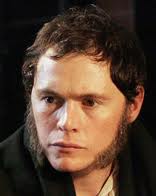Total Pageviews
Tuesday, 22 February 2011
AS ASPECTS OF NARRATIVE - TROTAM - Wednesday 23/2/2011
Here are the links to the compelling Richard Burton rendition of the poem: http://www.youtube.com/watch?v=RGH4p4z4s5A
and to view the Gustave Dore Mariner images which are useful for contextualising, particularly the archaic language follow:http://www.fantastichorror.com/02/coleridge-therimeoftheancientmariner123.html
Ensure you have the Aspects of Narrative checklist for the next lesson as we will be analysing each aspect in depth as we go through all of the texts. Moreover, check the previous pages for details of the link to Peter Ackroyd's excellent, essential programme (assonance or alliteration?) on the Romantics, Part 6 of 6 'Liberty', as I've said before - this is a must see resource - so do so! As it is so essential here it is again! http://www.youtube.com/watch?v=NopnhintB48
As you all agree that The Tragical History of Dr. Faustus will be our next text for study (Chaucer's The Pardoner's Tale in the 1-2-1 and Wednesday sessions for those who would like an additional text), then we really need to get on. To that end, and as you all felt that the production we saw at the Royal Exchange Theatre was far better, certainly far funnier, than the DVD production, then I'd like you to access the following links, the first to a review of the play: http://www.youtube.com/watch?v=YTJ4q8aPsoI
the second will allow you to watch the two main actors in that particular production talk about their preparations:
http://www.youtube.com/watch?v=QnkoD267PvU&feature=related
http://www.youtube.com/watch?v=QnkoD267PvU&feature=related
Read The Guardian review of the production, which has some interesting comments.
http://www.guardian.co.uk/culture/2010/sep/14/doctor-faustus-reviewHave a look at the story of Icarus and see if you can explain why Faustus, like Icarus, was known as the Overreacher.
Make sure you read scenes 1 and 2 for next Monday's lesson; from the outset analyse how Marlowe presents the two main protagonists: Faustus and Mephistophilis. Use the blue book to help you to identify the Gothic elements, make notes and bring them to the lesson - along with your opinions!
Y13 TEXTS AND GENRES LITB3 - 'WUTHERING HEIGHTS' Tuesday 22nd Feb 2011
 | ||||||||||||||||||
Here are all the images that you requested, particularly those of the younger generation:
Catherine Linton - (just watch the hair colour, it's the only way to avoid confusing her with Cathy!)
played by the French actress Juliette Binoche.
- Hareton Earnshaw
Not a lot to say about poor Hareton - but then he doesn't say much himself.
Linton Heathcliff -
Isabella Linton - played by the actor Sophie Ward
Hindley Earnshaw - status conscious as many of you stated on the characterisation activity; and then, in the second image less so as he began his inebriated descent.
Heathcliff - who else could it possibly be!
 |
| Nelly Dean |
Cathy
and last but not least Edgar Linton
Wednesday, 16 February 2011
Monday 21st February 2011. Year 12 Aspects of Narrative; Year 13 Texts and Genres
 FOR REVISION NOTES ON ALL A' LEVEL TEXTS LOOK AT THE ARCHIVE SECTION ----
FOR REVISION NOTES ON ALL A' LEVEL TEXTS LOOK AT THE ARCHIVE SECTION ----The Rime of the Ancient Mariner by Samuel Taylor Coleridge
It is an ancient Mariner,
And he stoppeth one of three.
'By thy long grey beard and glittering eye,
Now wherefore stopp'st thou me?
Homework: for Tuesday's class read Part 1 of 'The Rime of the Ancient Mariner' or TROTAM; remembering that this is one of Coleridge's poems of 'High Imagination' (along with 'Kubla Khan' and 'Christabel'). Look at the link below when reading the poem (in fact you can read it on this link) as it has some interesting images which correlate well with the poem: http://www.fantastichorror.com/02/coleridge-therimeoftheancientmariner123.html
He holds him with his glittering eye
The Wedding-Guest stood still,
And listens like a three years' child:
The Mariner hath his will.
If you'd rather hear someone else read the poem then follow this link to listen to the mellifluous tones of the great actor Richard Burton:
The poem is beautiful, compelling and confusing in equal measure; but let's just focus on the first two whilst we try to decide what type of text it actually is (for Kate Ashdown in emagazine it is a first-person narrative but with many different voices, within a third-person framework - so that's perfectly clear then?).
The Great Gatsby
 For this first lesson after the 'break' we will be returning to Chapter 1 of TGG, looking specifically at the title and at the narrator Nick Carraway, through whose eyes we witness American society. What is your opinion about the opening of the novel, how does it engage you, what and how does it tell us about Nick.
For this first lesson after the 'break' we will be returning to Chapter 1 of TGG, looking specifically at the title and at the narrator Nick Carraway, through whose eyes we witness American society. What is your opinion about the opening of the novel, how does it engage you, what and how does it tell us about Nick.and http://www.youtube.com/watch?v=X_g-0u1wfNc&feature=related
Both of which will provide you with useful contextual material on F Scott Fitzgerald's life, his work and (as with Miller) the nature of society at the time of his writing, along with the sources of his inspiration. These are all useful in enhancing your understanding of the text (remember AO4 - 'the significance and influence of the contexts...').
Accompanied by an article in the Washngton Post: http://www.washingtonpost.com/wp-dyn/content/article/2007/01/01/AR2007010100958.html
Homework: read Chapter 2 and make a note, a list even, of particular themes that you think are beginning to come through.
Subscribe to:
Comments (Atom)















